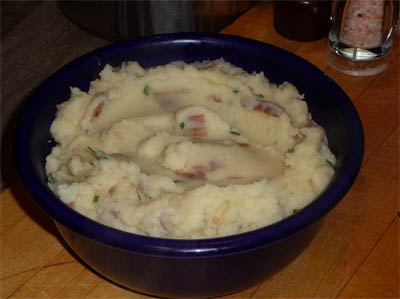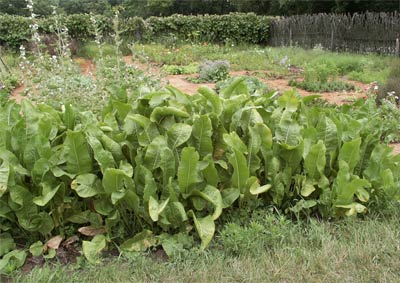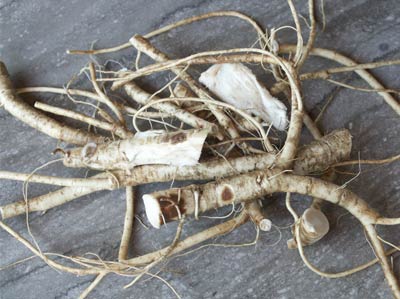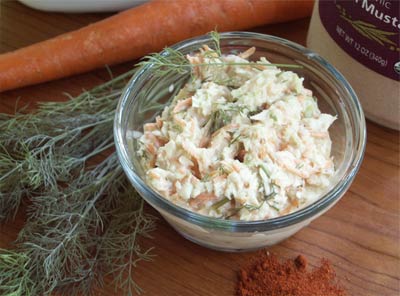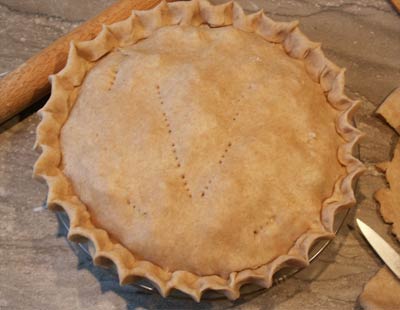Celebrate, Horseradish: Herb of the Year 2011
Back to the Root: Horseradish in the Kitchen
by Susan Belsinger
The pungent root of Armoracia rusticana adds assertive flavor to all types of dishes from cocktails to dessert. An essential ingredient to a proper Bloody Mary, horseradish adds a kick to this favorite savory libation or simple tomato juice. One of the most popular uses of horseradish, commercially and in the home kitchen, is in cocktail sauce. Made from ketchup and grated prepared horseradish, sometimes with a squeeze of lemon juice; this sauce is used as an accompaniment for shrimp, and bivalves such as clams, oysters and mussels and with breaded or battered fried fish. Try embellishing simple ho-hum tartar sauce with horseradish for an uplifting zing! Horseradish goes especially well with raw oysters, clams, roast meats, fish, and smoked foods. Fold freshly grated horseradish into just-whipped cream for a regal accompaniment to roast beef. The early, small tender leaves have a pleasant flavor with just a touch of pungency and can be added to salads. The grated root enlivens salads, soups, and sauces, and is often added to mayonnaises and mustards to make them more piquant. I like to use horseradish mayonnaise in coleslaw and potato salads, on sandwiches, with seafood, and as a dipping sauce for artichokes. You can mix fresh grated or prepared horseradish with mayonnaise, sour cream, yogurt, cream cheese or a combination thereof, embellish with chopped herbs such as garlic, parsley, chives, tarragon, basil, perhaps a little mustard, paprika, or a pinch of sugar or a dash of lemon juice or vinegar, and salt and pepper. Use this as a sauce for virtually anything—sandwiches, beef, fish, slaw, vegetables, potatoes or use it as a dip with vegetable crudités, crackers or chips.
I love horseradish with potatoes in any form; when mixed with sour cream and chives it is great on baked, steamed or oven-roasted potatoes. The aforementioned sour cream blend combined with boiled potatoes mashed with a little butter, milk and garlic makes for seriously scrumptious mashed potatoes. I often make mashies with turnips, sweet potatoes, rutabagas and/or parsnips which all combine well with horseradish.
Mashies with sour cream, chives and horseradish photo by Susan Belsinger
In eastern European cooking horseradish is popular in cream sauces, and, mixed with grated apples, or sometimes with grated beets, as a condiment with poultry, fish, and eggs. I enjoy it in deviled eggs, egg salad and even scrambled eggs. Horseradish changes vastly when cooked: when exposed to heat the mustard oils are destroyed so it loses its hotness and becomes rather earthy, sweet, and nutty, although a slight pungency remains. Add it to root vegetable soups, stews and chilis. I particularly enjoy it baked in all sorts of vegetable casseroles with root vegetables, winter squashes, and the brassicas.
Don’t forget the simplicity of a simple butter with horseradish, maybe an added minced herb—great on warm rolls or bread, veggies, potatoes, grilled or broiled fish—some even put it on top of a steak!
Most folks wouldn’t think of adding horseradish to a dessert. However, it does have an affinity with apples, and pears too, so be daring and try combining the grated root with fruit. It is lovely in applesauce and makes a tasty apple pie; I like the latter New England-style with a thin slice of sharp cheddar on top.
Since horseradish is full of nutrients like Vitamin C, iron, calcium, magnesium, phosphorus, potassium, and zinc; it is a circulatory and digestive stimulant; and has anti-depressant, antibacterial, anti-cancer, antioxidant, detoxifying and expectorant properties, I enjoy it often. (Note: avoid if you have an underactive thyroid).
Celebrate Horseradish, Herb of the Year 2011—
experiment with this pungent root—raw or cooked,
it will add zest to any dish!
Row of Armoracia rusticana in the home garden photo by Susan Belsinger
Preparation and Storage of Horseradish Root
If you are inspired to use horseradish but don’t have any in your garden, look in the market for long, thick, brown-skinned roots with gnarly knobs. They will be anywhere from 6 to 12 inches long and should be firm and free of soft spots. Roots with a greenish cast tend to have a bitter layer under the brown skin that should be trimmed away. Store roots in an open plastic bag in the refrigerator—as long as they are firm and free of mold, they are edible.
In most recipes, prepared horseradish may be used in place of freshly grated horseradish, though fresh horseradish will be hotter and more pungent. A rule of thumb is to substitute 4 teaspoons of prepared horseradish for 1 tablespoon of freshly grated horseradish. Because prepared horseradish is preserved with vinegar, you will need to adjust the recipe by deducting some lemon juice or vinegar from the recipe.
As freshly grated horseradish turns brown after grating and tends to lose its bite after sitting a while, it’s best to grate the root just before using it unless it is to be mixed into a sauce or preserved with vinegar. The hot mustard oil in horseradish dissipates with exposure to air, so grate it and use it fairly quickly. Fresh or bottled, horseradish should always be kept refrigerated: heat is the main enemy of this hot root. Even when refrigerated, prepared horseradish gradually loses its pungency. Plan to replace it after three or four months.
To preserve horseradish roots, remove the tough, brown outer skin with a sharp paring knife. (Manufacturers say that you do not have to peel it—just scrub it well—however you will have brown flecks in your finished product if you leave the skin on). Grate the roots on a grater or cut into cubes and process in a blender or food processor. Adding cold water and/or crushed ice will make the processing easier and also keep down the volatile fumes. Be sure there is adequate ventilation in the kitchen, and when you remove the top of the blender or processor, step back for a few minutes and do not inhale the fumes.
Let the roots sit for 5 to 10 minutes before combining with vinegar—processing with an acid such as vinegar or lemon juice right away will lessen the potency of the prepared horseradish.
For every 2 cups freshly grated horseradish, mix about 1/4 to 1/3 cup white vinegar (I use rice or white wine vinegar; apple cider vinegar also works well except the color is a bit darker) Some commercial prepared horseradishes also contain a little soybean oil, lemon juice, and/or sugar. Add salt to taste, about 1/2 to 1 teaspoon to 2 cups horseradish. If necessary, stir in a little more vinegar or water, to ensure that the mixture is well-moistened, yet not too liquid. Pack into sterilized jars, seal, and refrigerate. It is best to process in small amounts, since the prepared horseradish only lasts for about 3 months in the fridge.
Just-harvested roots from the home garden photo by Susan Belsinger
Coleslaw with Horseradish and Dill
I love coleslaw—it is one of my favorite salads. This is a tasty variation with the horseradish and dill. It is better the second day, or if you let it sit in the fridge for a few hours before serving.
Serves about 6
5 cups coarsely grated or finely shredded green cabbage
1 medium grated carrot
1/3 cup diced grated red or yellow onion
About 1/2 to 1 teaspoon salt
Freshly ground black pepper
Scant 1 cup good-quality mayonnaise
2 tablespoons freshly grated or prepared horseradish, or to taste
About 2 to 3 tablespoons chopped dill
About 2 tablespoons apple cider vinegar, preferably organic
About 1 1/2 tablespoons sugar or pure maple syrup
1/2 teaspoon Hungarian-style paprika, optional
Combine the cabbage, carrot and onion in a large bowl, season with salt and pepper (start with about 1/2 teaspoon of salt and scant 1/2 teaspoon pepper), and toss well. Add the mayonnaise, horseradish, dill, vinegar, and sugar or maple syrup. (I find if you use the syrup—you need a little more than when using sugar.) Sprinkle with the paprika if desired.
Cover and refrigerate for at least an hour. Remove from refrigerator, stir, and taste for seasoning. Adjust with a little more horseradish, vinegar, sugar, salt and pepper, or mayonnaise according to taste. Keep refrigerated until ready to serve; keeps about 3 to 4 days—the cabbage tends to get watery after a few days.
Coleslaw with horseradish is a favorite. photo by Susan Belsinger
Baltimore Bloody Mary with Horseradish
Here is a version of a Bloody Mary honoring horseradish as herb of the year. Although, last year I made one for Dill: Herb of the Year 2010—conscientiously I just couldn’t do a book on horseradish without one—it is the reason why a bartender keeps a jar at the bar. The famous Tulkoff horseradish processing plant is located in Baltimore and that is where Old Bay Seasoning originated—at the Baltimore Spice Company. Born and raised in Baltimore, I thought this an appropriate combination. It is zesty and delectable. I found organic cucumber vodka in my local liquor store and tried it—found it to be dynamite—or use your favorite good-quality vodka. I am a big fan of Tito’s organic vodka; it is well worth the cost of this smooth libation.
The amounts of horseradish and Tabasco are adjustable depending on your taste buds; if you prefer it more piquant add a little more. Be careful with the Old Bay since it has salt in it and you don’t want to oversalt the drink. The recipe is for one cocktail—it is easily doubled or quadrupled—and mixed together as a batch in a pitcher. For a delicious virgin version, just leave the vodka out.
Serves 1
1 cup V8 juice (or tomato juice—just not as flavorful)
1 1/2 ounces vodka
1 to 2 teaspoons fresh grated or prepared horseradish
About 3 dashes Tabasco
Few dashes Old Bay Seafood Seasoning
1/8 lemon (wedge)
Celery stalk, lemon wedge for garnish
Add the V8, vodka, horseradish, and Tabasco to a small pitcher and stir well. Add the Old Bay and squeeze in 1 lemon wedge and stir well. Taste for seasoning and adjust with more horseradish, Tabasco or Old Bay.
Take the other lemon wedge and run it lightly around the rim of a glass. Dip the rim into the Old Bay Seasoning to coat it lightly. Fill the glass halfway with ice cubes. Pour the stirred Bloody Mary into the glass. Garnish with the celery stalk and lemon wedge.
Apple Pie with Horseradish and Cheddar Cheese
Yes, a recipe for using horseradish in a dessert! This pie was meant to be—the apples and horseradish are a winning combination. Freshly grated horseradish must be used here because the prepared type contains vinegar and will alter the flavor noticeably. When horseradish is heated it turns nutty-sweet in flavor.
Makes one 9-inch pie
5 medium-large tart apples, preferably Stayman Winesap
2 1/2 tablespoons lemon juice
1/3 cup white sugar
1/3 cup brown sugar
3 tablespoons unbleached flour
1/4 teaspoon freshly grated nutmeg
1/4 cup freshly grated horseradish
2 9-inch pie crusts
Sharp cheddar cheese, optional
Preheat oven to 425° F. Peel the apples, core, and slice them into a bowl. As you slice them, add the lemon juice, a little at a time, to keep the apples from darkening. Add the sugars, flour, nutmeg, and horseradish, and toss well.
Roll the pie crusts out on a floured surface. Place the bottom crust in the pie plate, and evenly spread the apple mixture in it. Cover with the top crust, and crimp the edges decoratively. Prick the top crust with a fork in several places.
Bake the pie in the center of the oven for 10 minutes. Reduce heat to 350° F, and bake the pie for about 45 minutes longer, or until the top is golden brown. Remove the pie to a rack to cool. The pie is best served warm, not hot, or at room temperature. Serve with thin slices of cheddar cheese if desired.
Apple Pie with Horseradish photo by Susan Belsinger
